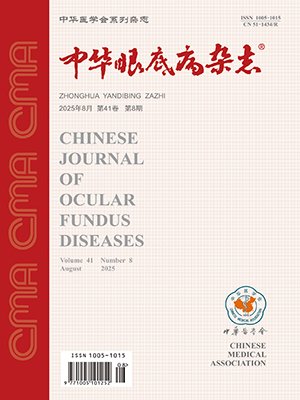Objective To evaluate the application value of iris fluorescein angiography (IFA) in the diagnosis of ischemic center retinal vein occlusion (CRVO). Methods Fifty-one patients (51 eyes) with CRVO which had been diagnosed by fundus fluorescein angiography (FFA)were studied. All patients underwent the examination of visual acuity, slit lamp biomicroscope,anterior segment color photography, intraocular pressure, FFA and IFA. The patients were classified as non-ischemic CRVO (20 eyes)and ischemic CRVO (31 eyes). The 20 non-ischemic CRVO patients included 11 males and nine females, aged from 41 to 59 years. The 31 ischemic CRVO patients included 21 males and 10 females, aged from 28 to 62 years.FFA and IFA were performed for all the patients using Heidelberg retina angiograph, and the classic pictures were analyzed by the computer image processing system. The detection rate of iris neovascularization (NVI) by slit lamp biomicroscope and IFA was analyzed. All ischemic CRVO eyes underwent panretinal photocoagulation (PRP), and PRP was completed in 27 eyes and not completed in four eyes. Six months after PRP the regression of iris NVI was followed up. Results All non-ischemic CRVO eyes (100.0%) had no neovascularization on papillary margin and iris by slit lamp biomicroscopy, and had no fluorescence (pigment blocked fluorescence) on IFA. Thirteen eyes (41.9%) and 23 eyes (74.2%) of the 31 ischemic eyes had NVI by slit lamp biomicroscope and IFA, respectively. The NVI detection rate of those two methods was statistically different (Z=-3.425,P=0.001). NVI showed b fluorescence and leakage with variable patterns (small blocks, thin lines and irregular cross-links) by IFA. There was no fluorescence staining and leakage on papillary margin and iris in 27 eyes who completed the PRP, but the neovascular glaucoma (NVG) occurred in one eyes who discontinued the PRP treatment after one to two months. Conclusions IFA has a high specificity in CRVO which hints the ischemic state of anterior segment. It is helpful to the early diagnosis of ischemic CRVO and the turnover of NVG.
Citation: 王丽丽,金丽英,张雯,何斌. Application of iris fluorescein angiography in the diagnosis of intraocular diseases. Chinese Journal of Ocular Fundus Diseases, 2011, 27(2): 123-126. doi: Copy
Copyright © the editorial department of Chinese Journal of Ocular Fundus Diseases of West China Medical Publisher. All rights reserved




